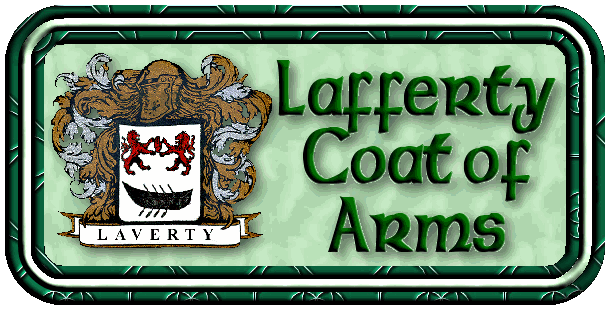
Another form of
the name Lafferty is “Laverty.” A coat of arms for the Laverty
clan has been found.
The official heraldic description of the Laverty Coat of Arms is
as follows:
Argent, 2 lions rampant combatant supporting a dexter hand
couped at the wrist all gules,
in base a boat with 8 oars sable.
This is a heraldic shorthand description of what is on the
shield, and translated into today's common language, it means
that the base color of the shield is argent - or silver-white.
This color denotes nobility, serenity and peace. It also is
associated with the quality of purity, because it withstands the
test of fire.
The next part of the description is what is on the upper half of
the shield. The Laverty shield contains the representation of
two lions facing each other in a rampant, combatant pose. The
lion, as the king of beasts, signified majesty and kingship from
early Roman times. In later use, the lions have become
emblematic of strength, courage, and generosity.
The lions are holding a human right (dexter) hand that is cut
off (couped) at the wrist. The color of the lions and the dexter
hand are all red, or gules as used in heraldry. The red
represents fortitude and creative power.
Another interpretation of the red hand cut off at the wrist is
associated with the legend of the "bloody hand of O'Neill".
Several ships were racing toward land, and it had been agreed
that the person who first laid his right hand on the shore would
lay claim to the land. When O'Neill saw that he was behind in
the race, he grabbed a sword, cut off his right hand, and heaved
it onto shore ahead of the others to claim the land. Thus, the
"bloody" red dexter hand has become a common Irish heraldic
symbol of ingenuity.
The final part of the description refers to what is in the base,
or bottom half, of the shield. The Laverty shield has a boat
with 8 oars. From earliest times, the symbol of a boat
represented security, stemming from the biblical story of Noah's
Ark. In more modern times, the boat is indicative of venture and
travel. The "sable" refers to the black color of the boat, which
is associated with night and repentance. The sable color is also
attributed to the quality of serenity.
This coat of arms has been certified by the Sanson Institute of
Heraldry. If you click on the image on the right, you will be
able to read the actual certificate.

(From David P. Laverty
http://www.laverty.org
November 3, 1997)
Heraldry really arrived in Ireland with the
Normans although there is evidence that the native Irish had a
pre-existing form of clan or family heraldic symbolism. Ireland
was among one of the first countries in the world to evolve a
system of hereditary surnames some of which can be traced back
to before the year 1000 AD. Therefore it is not surprising that
the Irish embraced heraldry with some enthusiasm. There are
three basic heraldic traditions in Ireland:
1) Norman, showing clearly its military origins, with a
preponderance of clear, simple devices designed for easy
recognition
2) 2) Anglo-Irish, characterized by great elaboration, with
individual shields often containing as many as a dozen charges,
reflecting the preoccupation with family relationships.
3) 3) Gaelic Irish, often relating to pre-Christian myths, with
symbols like the red hand. the oak tree and and the stag.
Now for the usual disclaimer. Great care needs to be exercised
when identifying with a particular coat of arms. Arms and the
right to bear them are granted to individuals and not to
families. In Ireland, however, it is traditional for sept
members to bear the arms of the clan head and this practice is
allowed by the Chief Herald. The origins of many modern Irish
surnames is far from clear. Bearers of a surname today may not
have even the remotest relationship to the original bearer of
the arms associated with it.
In short, to truly validate your family
coat of arms, you should not rely on these pages, but rather
contact the heraldic authority where the arms were granted.
Coats of arms are complicated things. The complete design
ensemble is called an achievement of arms and consists of
several parts; the escutcheon (shield); the helm, (helmet); the
crest; the motto; the mantle and the supporters.
Of these, the escutcheon or shield is the
most important. The helm was added to arms before the beginning
of the 14th century and in the 16th century, its form and
position were modified in English heraldry to indicate the rank
of the bearer. The crest is the oldest of armorial bearings
having its origins in ancient Greece and Rome. In heraldry it is
represented attached to the top of the helmet or above the
shield; its base is surrounded by a wreath, a circlet of twisted
ribbons tinctured of the principal metal and color of the
shield. The motto is a phrase or sentence alluding to the
family, the arms, or the crest. It is placed in a scroll above
the crest or below the shield. The mantle originally was a
representation of the piece of cloth that protected the helmet
from the heat of the sun. It became more decorative and was
usually shown in the principal colors of the shield. The
supporters are figures, usually people or animals, placed either
side of the shield. In English (and Irish) heraldry, only
certain nobility and royalty are permitted supporters and so
most arms do not include them.
(From
http://www.clansandnames.org/guestbook/lafferty.shtml)




